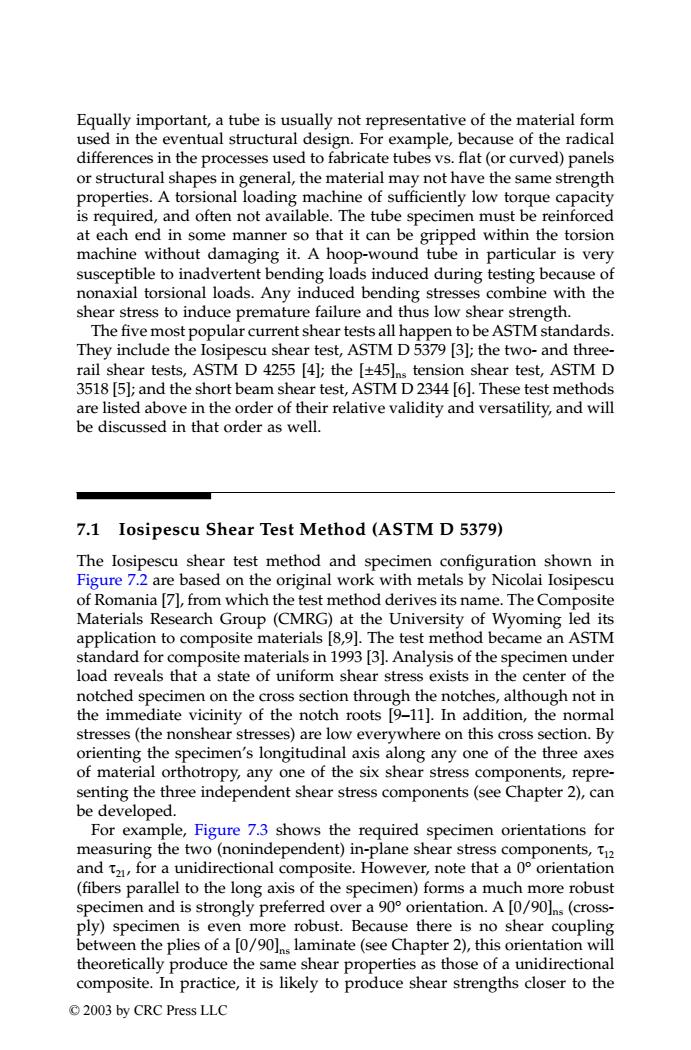正在加载图片...

Equally important,a tube is usually not representative of the material form used in the eventual structural design.For example,because of the radical differences in the processes used to fabricate tubes vs.flat(or curved)panels or structural shapes in general,the material may not have the same strength properties.A torsional loading machine of sufficiently low torque capacity is required,and often not available.The tube specimen must be reinforced at each end in some manner so that it can be gripped within the torsion machine without damaging it.A hoop-wound tube in particular is very susceptible to inadvertent bending loads induced during testing because of nonaxial torsional loads.Any induced bending stresses combine with the shear stress to induce premature failure and thus low shear strength The five most popular current shear tests all happen to be ASTM standards. They include the Iosipescu shear test,ASTM D 5379 [3];the two-and three- rail shear tests,ASTM D 4255 [4];the [+45]ns tension shear test,ASTM D 3518 [5];and the short beam shear test,ASTM D 2344 [6].These test methods are listed above in the order of their relative validity and versatility,and will be discussed in that order as well. 7.1 Iosipescu Shear Test Method (ASTM D 5379) The losipescu shear test method and specimen configuration shown in Figure 7.2 are based on the original work with metals by Nicolai losipescu of Romania [7],from which the test method derives its name.The Composite Materials Research Group(CMRG)at the University of Wyoming led its application to composite materials [8,9].The test method became an ASTM standard for composite materials in 1993 [3].Analysis of the specimen under load reveals that a state of uniform shear stress exists in the center of the notched specimen on the cross section through the notches,although not in the immediate vicinity of the notch roots [9-11].In addition,the normal stresses(the nonshear stresses)are low everywhere on this cross section.By orienting the specimen's longitudinal axis along any one of the three axes of material orthotropy,any one of the six shear stress components,repre- senting the three independent shear stress components(see Chapter 2),can be developed. For example,Figure 7.3 shows the required specimen orientations for measuring the two(nonindependent)in-plane shear stress components,t2 and ta,for a unidirectional composite.However,note that a 0 orientation (fibers parallel to the long axis of the specimen)forms a much more robust specimen and is strongly preferred over a 90orientation.A[0/90]s(cross- ply)specimen is even more robust.Because there is no shear coupling between the plies of a [0/90]ns laminate(see Chapter 2),this orientation will theoretically produce the same shear properties as those of a unidirectional composite.In practice,it is likely to produce shear strengths closer to the ©2003 by CRC Press LLCEqually important, a tube is usually not representative of the material form used in the eventual structural design. For example, because of the radical differences in the processes used to fabricate tubes vs. flat (or curved) panels or structural shapes in general, the material may not have the same strength properties. A torsional loading machine of sufficiently low torque capacity is required, and often not available. The tube specimen must be reinforced at each end in some manner so that it can be gripped within the torsion machine without damaging it. A hoop-wound tube in particular is very susceptible to inadvertent bending loads induced during testing because of nonaxial torsional loads. Any induced bending stresses combine with the shear stress to induce premature failure and thus low shear strength. The five most popular current shear tests all happen to be ASTM standards. They include the Iosipescu shear test, ASTM D 5379 [3]; the two- and threerail shear tests, ASTM D 4255 [4]; the [±45]ns tension shear test, ASTM D 3518 [5]; and the short beam shear test, ASTM D 2344 [6]. These test methods are listed above in the order of their relative validity and versatility, and will be discussed in that order as well. 7.1 Iosipescu Shear Test Method (ASTM D 5379) The Iosipescu shear test method and specimen configuration shown in Figure 7.2 are based on the original work with metals by Nicolai Iosipescu of Romania [7], from which the test method derives its name. The Composite Materials Research Group (CMRG) at the University of Wyoming led its application to composite materials [8,9]. The test method became an ASTM standard for composite materials in 1993 [3]. Analysis of the specimen under load reveals that a state of uniform shear stress exists in the center of the notched specimen on the cross section through the notches, although not in the immediate vicinity of the notch roots [9–11]. In addition, the normal stresses (the nonshear stresses) are low everywhere on this cross section. By orienting the specimen’s longitudinal axis along any one of the three axes of material orthotropy, any one of the six shear stress components, representing the three independent shear stress components (see Chapter 2), can be developed. For example, Figure 7.3 shows the required specimen orientations for measuring the two (nonindependent) in-plane shear stress components, τ12 and τ21, for a unidirectional composite. However, note that a 0° orientation (fibers parallel to the long axis of the specimen) forms a much more robust specimen and is strongly preferred over a 90° orientation. A [0/90]ns (crossply) specimen is even more robust. Because there is no shear coupling between the plies of a [0/90]ns laminate (see Chapter 2), this orientation will theoretically produce the same shear properties as those of a unidirectional composite. In practice, it is likely to produce shear strengths closer to the TX001_ch07_Frame Page 106 Saturday, September 21, 2002 4:58 AM © 2003 by CRC Press LLC